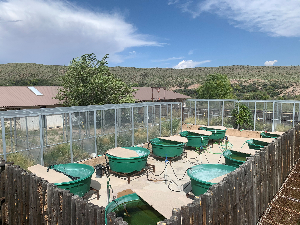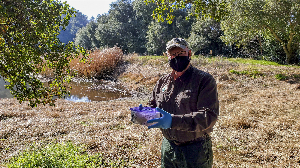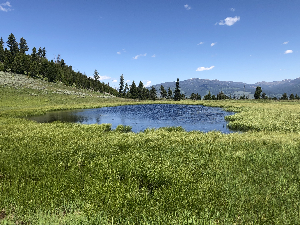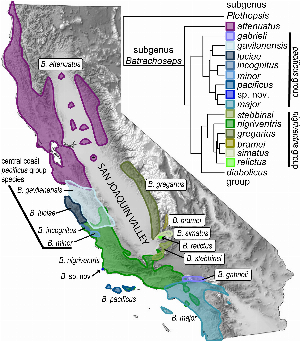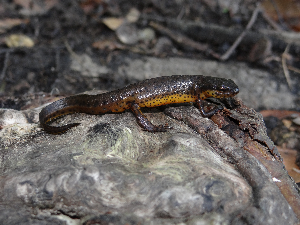Search ARMI Database
Search term(s)
Contribution Number
Search Results
91 record(s) found.
News & Stories ARMI Scientists participate in first Global Amphibian and Reptile Disease Conference
The first Global Amphibian and Reptile Disease Conference was held in Knoxville, Tennessee in July 2022. ARMI scientists E. Muths and B. Hossack presented a synthesis of efforts to understand amphibian disease in the Greater Yellowstone Ecosystem, and B. Hardy and L. Bailey, a PhD student and ARMI affiliate (respectively) at Colorado State University, presented a paper on the potential for demographic compensation in amphibian populations challenged by disease. These presentations were among the few field-based papers at the conference. ARMI scientists E. Grant and M. Bletz led one of the conference workshops to discuss and design conceptual disease models for major herpetofaunal pathogens. The aim of this workshop was to identify differences in knowledge, processes, and possible management strategies among host-pathogen systems. In addition, M.C. Hopkins, Wildlife Disease Coordinator, USGS Ecosystems Mission Area, was a member of the Scientific Committee for the conference.
The goal of the GARD conference was to engage a wide range of people, from scientists and students to veterinarians, natural resource managers, and policy makers, in sharing knowledge about various amphibian and reptile diseases and in working to identify disease management strategies that are applicable to herpetofauna conservation. This hybrid meeting hosted scientists from 25 countries, with presentations ranging from the research reports, including the roles of biodiversity and climate change in amphibian disease risk and amphibian disease immunogenetics, to broad keynotes, such as “Comparative ecology and evolution of reptile pathogens” and “Ranaviruses: four things we (mostly) know and three we (largely) do not”.
News & Stories ARMI scientists lead analysis of factors linked with long-term reintroduction success for a threatened frog
Reintroduction programs are growing in use to help recover imperiled species. However, there is still little information on the long-term success of these programs or factors linked with successful establishment of populations. ARMI scientists collaborated with partners from the US Fish and Wildlife Service, Arizona Game and Fish Department, Turner Endangered Species Fund, and university scientists to analyze 25 years of reintroductions for the Chiricahua Leopard Frog in Arizona and New Mexico. The reintroduction program stocks larvae and frogs reared in several captive and semi-captive facilities in the region, as well as egg masses and frogs moved from wild sources. The results from the study can help improve reintroduction success and speed recovery for the Chiricahua Leopard Frog and other species with similar life histories.
Citation
Hossack and others. 2022. Identifying factors linked with population persistence: Lessons learned from 25 years of amphibian translocations. Global Ecology and Conservation 35: e02078. https://doi.org/10.1016/j.gecco.2022.e02078
News & Stories Dr. Cecil Schwalbe
Dr. Cecil Schwalbe passed away on 3 April 2022 from complications after a heart attack and pneumonia. Cecil was one of the early Principal Investigators for ARMI. His lab provided long term data from the desert southwest on summer breeding amphibians, bullfrog eradication, disease, and leopard frog conservation. Cecil’s work at Buenos Aires National Wildlife Refuge laid a foundation for additional ARMI efforts in expanding model development on occupancy, spatially explicit metapopulation theory, Chiricahua leopard frog survival, and habitat connectivity. ARMI post doc Richard Chandler and graduate students Chris Jarchow and Paige Howell led this work, but Cecil was supportive and interested in the research and how it contributed to conservation efforts (e.g., Chandler et al. 2015, Jarchow et al. 2016, Howell et al. 2016, 2018, 2019).
Cecil also contributed to collaborative ARMI efforts (e.g., Muths et al. 2005) and was always present at ARMI meetings to keep things field-oriented and to maintain an appropriate sense of humor. He retired from ARMI and the USGS in 2013, but remained active in the herpetological community. Cecil was an old-school herpetologist and while he would rather be investigating frog populations in the field or showing Gila monsters to school kids, he would thoughtfully listen to the reasoning behind monitoring protocols and models and provide input on field implementation for ARMI projects.
In addition to his PhD in zoology and physiology from the University of Arizona and a master’s degree from Washington State, Cecil held a bachelor’s degree in mechanical engineering from Rice University and was Arizona’s first State Herpetologist. His enthusiasm and dedication to conservation influenced many young scientists including some of us in ARMI. In recognition of his mentoring and influence, Cecil received the Jarchow Conservation Award in 1997 and the Charlie W. Painter Memorial Award in 2021 from SW Partners in Amphibian and Reptile Conservation.
Cecil is survived by his wife Carol, sons Adam and Ethan, two granddaughters, and his sister. The family requests that in lieu of flowers, donations be made in memory of Cecil, to the Cold-Blooded Research Fund in the School of Natural Resources and the Environment at the University of Arizona: https://give.uafoundation.org/cecilschwalbe. In keeping with Cecil’s profession and passion, the annual payout from this endowed fund will support research awards for undergraduate students, graduate students and faculty members who are studying amphibians, reptiles, or fish.
Cecil’s laugh and his off-color sense of humor will be missed by all of us and the herpetofauna that he cared about.
News & Stories Collaborative ARMI work provides critical information for cave salamander species status assessment
As part of a partnership with Smithsonian Institution and multiple university scientists, ARMI has assembled multiple data sources into a publication on the current status of the WV spring salamander, a rare amphibian with known range limited to a single cave in WV. This work is an important contribution to research on the species, which has been proposed for listing under the Endangered Species Act. Because species identification is made via morphological traits, ARMI sought experts on amphibian systematics to assess sources of misidentification error, which will be used to improve the precision and reduce the bias in field surveys. Using both field collected samples and museum specimens, collaborators updated genetic analyses to assess the divergence of the species from its close relative, the Northern spring salamander. Although contemporary water quality assessments identified no significant contamination threats, population estimates since the 1970s suggest large fluctuations in observed population size. These results will soon be published in the journal Conservation Genetics and are under review by USFWS as part of the listing decision, due in 2023.
News & Stories ARMI Scientists Collaborate with NPS on Special Issue Focused on Amphibian and Wetland Conservation in the GYE
USGS-ARMI and scientists from the NPS Greater Yellowstone Inventory & Monitoring Network organized a special issue in the journal Ecological Indicators. This special issue was spawned by a virtual 3-day science symposium in December 2020 that was entitled Linking Monitoring and Research to Amphibian Conservation in the Greater Yellowstone Ecosystem. The papers in the special issue highlight collaborative USGS–NPS research on amphibians, wetlands, and climate, as well as emerging tools and priorities for scientists and resource managers. The special issue contains 11 papers focused on many of these same themes, including 6 papers that were led or co-authored by ARMI investigators. Notable USGS-ARMI contributions include an analysis of long-term responses of amphibian populations to wetland mitigation; a synthesis of amphibian disease research in the GYE; reflections on the 15-year NPS monitoring program in Grand Teton and Yellowstone national parks, including recommendations on how to enrich information from monitoring by incorporating new sampling technologies, adopting advances in analytical approaches, and integrating climate forecasts into wetland and amphibian assessments; and a paper that examines the important historical and future roles of NPS lands and management nationwide in amphibian conservation.
You can access the special issue here: https://www.sciencedirect.com/journal/ecological-indicators/special-issue/103RXWLVGZM
News & Stories Update to annotated bibliography of grazing effects on amphibians and their habitats
USGS researchers recently published an update to the 2020 ‘Annotated bibliography of grazing effects on amphibians and their habitats’ data release, a global synthesis of literature pertaining to livestock grazing effects on amphibians and their habitats. The update includes an additional 10 grazing-related publications that were released between 2020 and 2021. The data release features an interactive search tool, which has also been updated. Users of the annotated bibliography search tool can query records by user-defined criteria and output results in report format. This tool aids users in synthesizing research related to a range of specific questions and should assist land managers in evaluating and implementing grazing while maintaining habitat for wetland amphibians.
You can access the updated search tool here: https://doi.org/10.5066/P9GGPPF7
News & Stories The return of red-legged frogs
Multiple partners from national and international nonprofits, government agencies, private landowners come together to change the course of the frog’s plight.
Read the full story here: https://www.fws.gov/cno/newsroom/Highlights/2021/Red-Legged-Frog/
News & Stories ARMI Scientists Assist NPS Monitoring Program with Symposium and Program Review
During December 8–10, 2020, the NPS-Greater Yellowstone Network hosted a virtual three-day amphibian and wetland science symposium entitled Linking Monitoring and Research to Amphibian Conservation in the Greater Yellowstone Ecosystem. This symposium highlighted work related to the NPS program that has monitored amphibian and wetland dynamics in Grand Teton and Yellowstone national parks since 2006. USGS-ARMI has been linked with monitoring program since the inception of the NPS monitoring program and assisted with organizing symposium presentations.
The three-day symposium served two important purposes. The first two days were intended to bring together practitioners of amphibian monitoring and park natural resource personnel with university, non-governmental scientists, and USGS scientists. Participants shared examples from their work and the current state of knowledge about research and monitoring of amphibians and their habitats. Reflecting the long history of ARMI research in the Rocky Mountains and on NPS lands, there were five presentations by ARMI scientists, and seven presentations highlighted on-going or recently completed ARMI research.
The third day was structured to provide a formal peer review of the network’s amphibian and wetland monitoring protocol. The eight reviewers, which included ARMI scientist Brian Halstead and former ARMI PhD student Paige Howell, offered recommendations to enrich and strengthen the Greater Yellowstone Network ’s ongoing monitoring efforts. In total, more than 60 people participated in the symposium and program review.
ARMI and the Greater Yellowstone Network will continue their collaboration by co-organizing a special issue in the journal Ecological Indicators. The issue will include several papers that highlight collaborative USGS-NPS research on amphibians, wetlands, and climate, as well as emerging tools and priorities for scientists and resource managers.
News & Stories Information from ARMI surveys guides management action in the Desert Southwest
The Buenos Aires National Wildlife Refuge (BANWR) has developed a new pond designed to replicate ciénega conditions that will provide habitat for the federally threatened Chiricahua leopard frog. Reintroduced to the Refuge after extirpation in the early 2000s, the Chiricahua leopard frog has colonized areas beyond the initial reintroduction sites, now inhabiting several human-made stock tanks on the Refuge. The species’ persistence on the Refuge depends on the ongoing eradication of invasive bullfrogs and the availability of water. In desert habitats such as BANWR, the ciénega (a Spanish word for wetland) is a marsh-like habitat that is critical for numerous desert-dwelling creatures. Ciénegas on BANWR are characterized by a spring or seep that saturates the soil and allows water to pool in small areas (Hendrickson and Minckley, 1985). Ciénega vegetation includes rushes, watercress, and smartweed; they are often bordered by cottonwood and willow trees which the Refuge will plant at the new ciénega once the water has settled into the excavated depression. The new ciénega on BANWR is plumbed, meaning that water levels can be modified and maintained in response to environmental conditions that range from multi-year droughts to heavy monsoon conditions (Bezy et. al. 2007).
ARMI has collected data at BANWR since 2000, gathering information about native species (e.g., Chandler et al. 2015, Jarchow et al. 2016, , Howell et al. 2018, 2020a), invasive species such as American bullfrogs and sunfish (Suhr 2010, Howell et al. 2020b), and disease (Sigafus et al. 2014). Models assessing occupancy and movement of the Chiricahua leopard frog indicate that water availability and permanency are critical components to the its persistence at BANWR. The Refuge has used this information to make decisions about management actions such as building plumbed ponds — a non-trivial action in terms of cost and logistics. The new ciénega will not only support the Chiricahua leopard frog but will provide water for many other species that call BANWR home including the federally endangered masked bobwhite quail, great blue herons, yellow-billed cuckoos, and pronghorn.
Bezy, J., C. F. Hutchinson, and C. J. Bahre. 2007. Buenos Aires National Wildlife Refuge, 373 Arizona. Desert Plants 23:3–44.
Chandler, R., E. Muths, B. H. Sigafus, C.R. Schwalbe, C. Jarchow, and B.R. Hossack. 2015. Realizing the potential of spatially explicit metapopulation theory for predicting extinction risk. Journal of Applied Ecology. DOI: 10.1111/1365-2664.12481.
Howell, P., E. Muths, B.R. Hossack, B.H. Sigafus, and R.B. Chandler. 2018. Increasing connectivity between metapopulation ecology and landscape ecology. Ecology 99: 1119-1128.
Howell, P.E., B.R. Hossack, E. Muths, B. Sigafus, A. Chenevert- Steffler, and R. Chandler. 2020a. A statistical forecasting approach to metapopulation viability analysis. Ecological Applications 30(2), e02038
Howell, P.E. E. Muths, B.H. Sigafus, and B.R. Hossack. 2020b. Survival estimates for the invasive American bullfrog. Amphibia-Reptilia.
Hendrickson, D. A. and W. L. Minckley. 1985. Ciénegas vanishing climax communities of the American southwest. Desert Plants 6 (3): 131-175.
Sigafus, B. H., C.R. Schwalbe, B.R. Hossack, and E. Muths. 2014. Prevalence of the amphibian chytrid fungus at Buenos Aires National Wildlife Refuge, Arizona. Herpetological Review 45: 41-42.
Suhre, D. O. 2010. Dispersal and demography of the American Bullfrog (Rana catesbeiana) in a 455 semi-arid grassland. M.S. Thesis, University of Arizona, USA.
News & Stories Urban Southern California is a Center of Diversification for Salamander Lineages
The Southern California Biodiversity Hotspot has a complex geological history and has a human population of about 24 million people. A recent study of genetic diversity across salamanders that occur here found high levels of localized diversity representing ancient mitochondrial lineages. Several of these lineages are very geographically limited and occur only within this urban matrix. Each of the three National Parks (Channel Islands National Park, Santa Monica Mountains National Recreational Area, and Cabrillo National Monument) in this southern California landscape will be important for the long term persistence of unique lineages that are almost micro-endemics to just these park units. Various Bureau of Land Management lands in this regional also house highly divergent lineages that could serve as conservation targets. Lastly, this work provides further support for the importance of the continued US Fish and Wildlife program of Habitat Conservation Planning within this Biodiversity Hotspot for conserving undescribed ancient patterns of genetic diversity.
News & Stories Devastating Salamander Chytrid Fungus Not Detected in National Survey Led by ARMI
The salamander chytrid fungus (Batrachochytrium salamandrivorans), commonly known as Bsal, has caused massive mortality of salamanders in Europe. There is a high potential for spread of the disease to North America through the international pet trade. Because North America has the highest diversity of salamanders in the world there is heightened concern about the potential for this devastating disease if it becomes established in the U.S. The U.S. Fish and Wildlife Service declared many salamanders as injurious under the Lacey Act and prohibits the importation of them to the U.S., but there are still potential means for the disease to spread. We conducted a large-scale surveillance effort for Bsal across the U.S. taking 11,189 samples from 594 sites in 223 counties within 35 U.S. states and one site in Mexico. We targeted sites that were believed to have high risk of Bsal introduction or where the consequence of a Bsal introduction would be high. We sampled for Bsal by swabbing amphibians, primarily newts, and attempting to detect the DNA of Bsal using standard genetic techniques. We found no evidence of Bsal in any of our samples, and our modeling suggests that it is highly unlikely that Bsal is widespread if it is present at all in North America at this time. The apparent absence of Bsal in North America suggests that efforts to prevent and prepare for its introduction are productive.
News & Stories Race to save rare California frog beats coronavirus lockdown
This week in the Los Angeles Times, ARMI biologists and Mexican biologists are highlighted in their effort to translocate eggmasses of the endangered California Red-legged Frog from San Pedro Martir range to the Santa Rosa Plateau and Santa Ana Mountains. Full article is available here: https://www.latimes.com/environment/story/2020-04-09/scientists-beat-coronavirus-lockdown-to-save-rare-california-frog
The official press release by the The San Diego Natural History Museum also covers this project (in which they play an important role): https://www.sdnhm.org/pressroom/pressroom_details/california-red-legged-frogs-returned-to-historic-range-in-southern-california/37/?utm_source=twitter&utm_medium=social&utm_term=035dad5c-1a08-40c5-b9af-94bd2ecc5a17&utm_content=&utm_campaign=usgs
We also earned a spot on the USGS Facebook page which can be seen here: https://www.facebook.com/USGeologicalSurvey/posts/3034689379910358
News & Stories Annotated bibliography of grazing effects on amphibians and their habitats
Livestock grazing is one of the most common land uses in the western United States, where multiple amphibians of conservation concern use habitats that are grazed. Despite the common intersection of grazing and sensitive amphibian species, there are very few reviews of research related to the issue. USGS researchers compiled and summarized literature pertaining to livestock grazing effects on amphibians and their habitats, with an emphasis on wetland-breeding species in the western United States. Users of the annotated bibliography can utilize an integrated search tool with user-defined criteria to query records and output results. This tool aids users in synthesizing research related to a range of specific questions and should assist land managers in evaluating and implementing grazing while maintaining habitat for wetland amphibians.
You can find the search tool here: https://doi.org/10.5066/P9GGPPF7
News & Stories Honoring the late Gary Fellers
SACRAMENTO, Calif. – Dr. Gary Fellers, researcher emeritus with the U.S. Geological Survey, passed away last month after a 40-year career as an ecologist with the USGS Western Ecological Science Center and the National Park Service. He was a pioneer in herpetology – the study of amphibians and reptiles – and helped bring to light the worldwide decline of amphibians. Dr. Fellers was one of the Principal Investigators for ARMI. To download his obituary that was published in Herpetological Review, please visit: https://armi.usgs.gov/docs/Gary_Fellers_obit_in_HR.pdf
News & Stories ARMI scientist Michael Adams receives 2020 PARC honor
Dr. Michael Adams, Lead for the USGS Amphibian Research and Monitoring Initiative (ARMI) and Supervisory Research Ecologist at the USGS Forest and Rangeland Ecosystem Science Center, has been selected to receive the 2020 Partners in Amphibian and Reptile Conservation (PARC) Alison Haskell Award for Excellence in Herpetofaunal Conservation.
This award recognizes individuals in North America who exemplify extraordinary commitment to herpetofaunal conservation. The PARC Joint National Steering Committee (JNSC) was impressed with the multitude of examples that spanned local to global partnerships affecting international conservation efforts, such as serving as the Surveillance/Monitoring lead on the Bsal Task Force.
“Your ability to connect people and science at multiple levels and to facilitate key partnerships while providing rigorous science to meet local, regional, national, and international management needs in the field of amphibian ecology and conservation is indeed striking,” the JNSC letter stated.
In addition, Mike’s leadership and behind the scenes work as National Coordinator for the USGS Amphibian Research and Monitoring Initiative has been recognized as the sustaining force behind the national program, a program of excellence in science and conservation that is unparalleled by any other federal government effort and is a model for other nations.
Mike’s outstanding passion for, and dedication to, conservation of amphibians and reptiles was recognized by the JNSC through, “...your leadership, science, and collaborations. Your contributions to herpetofaunal conservation exemplifies all of our Core Values: Collaboration; Proactive Approaches; Scientific Integrity; Value in All Biodiversity; and Maintaining Optimism and fits our desire to acknowledge "unsung heroes" in herpetofaunal conservation.”
Mike will receive the award on March 20, 2020 at the North American Wildlife and Natural Resources Conference in Omaha, Nebraska.
News & Stories ARMI in the news - Recovery: Saving Mark Twain’s Famous Frog
There’s good news about amphibians, and it’s an important antidote for hopelessness.
The main character of Mark Twain’s first literary success, The Celebrated Jumping Frog of Calaveras County, was a California red-legged frog whose noted leaping ability was annulled by birdshot surreptitiously forced down its throat.
When The New York Saturday Press ran the story on November 18, 1865 California red-legged frogs were so abundant in and near the state’s coastal areas they provided a booming market for frog legs.
Today the West’s largest native frog is missing from 70 percent of its historic range and listed as federally threatened. Likely causes include an alien amphibian disease called chytrid fungus, development, urban runoff, water loss from diversions, drought and fire from climate change, past predation by humans and current predation by non-native fauna.
But recovery efforts by multiple partners, including The Nature Conservancy, are producing spectacular results.
View full article: https://blog.nature.org/science/2019/11/14/recovery-saving-mark-twains-famous-frog/
News & Stories ARMI scientists participate in International Symposium: Amphibian population declines – 30 years of progress in confronting a complex problem. Montreal, Canada
Scientists first became concerned that the observations of declining or lost amphibian populations were not isolated incidents but were global in scope and severity at the landmark 1st World Congress of Herpetology in Canterbury England in 1989. The plight of amphibians became front-page news and the newly generated interest in their population biology generated a massive increase in our understanding of their ecology, epidemiology and conservation biology. To mark 30 years of research into amphibian population declines, the Redpath Museum and McGill University in Montreal held an international symposium on amphibian ecology and conservation biology to bring together many of the principle researchers now making significant advances in the field. Evan Grant and Erin Muths, Principle Investigators for ARMI, were invited participants to the symposium held in September. Dr. Grant presented a lecture on lessons from broad-scale synthetic analyses about drivers of decline and Dr. Muths presented on the effects of disease, temperature, and community on demography and how analytical advances allow us to address more complex questions about decline. Both topics will be featured manuscripts in the forthcoming special issue of the journal Herpetologica.
News & Stories Monterey salamander finding at San Diego National Wildlife Refuge prompts biologists to test for deadly fungus
Cold, dark and rainy nights are not your typical postcard picture of San Diego, but these are just the type of nights that reptile experts wait for in early spring.
Robert Fisher from the U.S. Geological Survey is one of those reptile experts, known as herpetologists. On a hunch and from his extensive knowledge of amphibians in Southern California, he set out in early February with a small team of biologists in search of a specific species; located in a closed area of the San Diego National Wildlife Refuge.
Fisher predicted that with the unique soil and plant types found on San Miguel Mountain, along with its higher elevation and longer exposure to moisture in the air, he might find the species he had in mind: the Monterey salamander (Ensatina eschscholtzii eschscholtzii). Then if any were found, they would come back to collect tissue samples to test for a deadly fungus specific to salamanders, called chytrid fungus.
Full text: https://www.fws.gov/cno/newsroom/highlights/2019/monterey_salamander/
News & Stories Exploring the amphibian exposome in an agricultural landscape using telemetry and passive sampling
USGS and Iowa State University scientists quantified Northern Leopard frog exposure to pesticides in aquatic and terrestrial habitats using a novel combination of radio telemetry and passive sampling techniques to better understand factors affecting frog health and survival in agricultural landscapes. The results of this newly published research can inform conservation strategies by providing information about when and where the frogs are most likely exposed to pesticides. This unique approach can be utilized in other land-use settings and with other amphibian species to better understand if contaminant exposure affects growth, development, fitness, and survival.
Full article is available here: https://www.nature.com/articles/s41598-018-28132-3
News & Stories Collaborative ARMI work first step in status assessment for cave salamander
As part of a partnership with the USFWS, WV Division of Natural Resources, and The Nature Conservancy, Northeast ARMI staff and a USGS Water Resources hydrologist conducted a field survey in late August for the WV spring salamander, a rare amphibian with known range limited to a single cave in WV. This work is an important contribution of the status assessment for the species, which has been proposed for listing under the Endangered Species Act. Species identification is made via morphological traits, but these may be imperfect, and thus misidentification is highly likely. ARMI is developing models that can accommodate this misidentification error, which will be used to improve the precision and reduce the bias in estimates of population status. In addition to field surveys, USGS ARMI will contribute morphologic and genetic analyses, and water quality assessment to identify and characterize potential threats, to address information needs for the USFWS listing decision, due in 2020.


